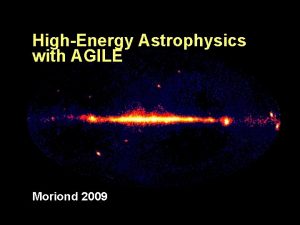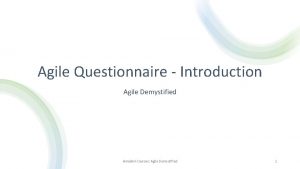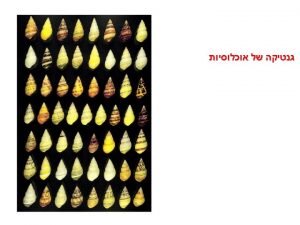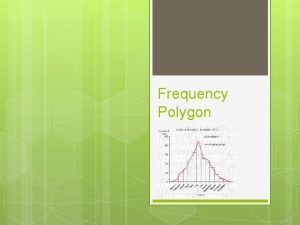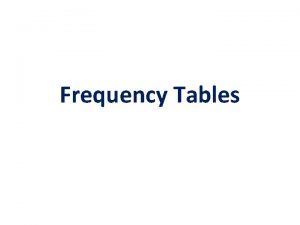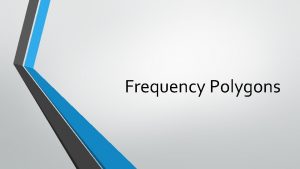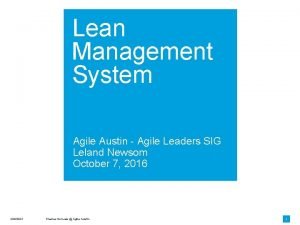The Frequency Agile System The Frequency Agile System

























- Slides: 25


The Frequency Agile System § The Frequency Agile System Provides A New Concept for Naval Target Control: § Senses RF Interference or Multipathing and Automatically Changes Frequencies To Avoid It § Provides Multiple High-Speed RF Networks For Complex Target Operations § Compatible With Existing Ground Systems, Such As the System for Naval Target Control (SNTC) 1 November 2005 NDIA Targets Symposium 2

Components Of The Frequency Agile System (FAS) Omni-Directional Antenna FAS Transponders RF Data Link FAS Ground RF Unit* To Ground Control System 19 Channels 421. 5 MHz to 448. 5 MHz FAS Airborne Relay* FAS Test Set* * Photographs Provide Conceptual Illustrations Of Anticipated FAS Equipment NDIA Targets Symposium 1 November 2005 3

FAS Facts 1. FAS Provides 200 NM Line Of Sight Distance with 12 d. B of Margin • • • 330 NM Over The Horizon With One Relay Hop (Standard) 730 NM Over The Horizon With Two Relay Hops (Optional) Relay Track Information Is Provided By The Data Link 2. 46 16 -Bit Words Are Provided In Each Uplink/Downlink Message • • Includes Time, Space, Position Information (TSPI) 9 Times More Data Than The Current SNTC, Similar To GRDCS 3. Selectable Uplink/Downlink Rates • • • 1 November 2005 Each Participant Can Have Its Own Uplink/Downlink Rate Selectable From 1 Hz, 5 Hz, 10 Hz or 15 Hz Uplink/Downlink Rates Remain Fixed During The Mission NDIA Targets Symposium 4

More FAS Facts 4. Can Operate With 1 to 4 RF Networks Simultaneously • 5. Example: One RF Network Could Be Used for Subscale Operations, One for Full Scale Operations, and One for Maintenance Operations A Migration Path Is Provided To Satellite Command & Control • • Iridium Satellite Module Is A Pre-Planned Product Improvement (P 3 I) Electrical & Mechanical Interfaces Provided On All FAS Transponders 6. Can Operate In GPS-Denied Environments • • • 1 November 2005 Selective Availability Anti-Spoofing Module (SAASM) Is A P 3 I Electrical & Mechanical Interfaces Provided On All FAS Transponders If L 2 Band Is Also Denied, TSPI Can Be Obtained From External INS NDIA Targets Symposium 5

FAS Transponder System Optional Iridium Module Optional SAASM Module FAS Transponder 1 November 2005 NDIA Targets Symposium 6

The Frequency Agile System Is Portable FAS can operate independently of any range or can be integrated with other range systems, such as GRDCS. This figure illustrates how the FAS could be installed and operated with GRDCS while maintaining the existing 915 MHz data link. 1 November 2005 NDIA Targets Symposium 7

Goals Of The Frequency Agile System Was Conceived During A Study Commissioned By Navy PMA-208 To Address The Following Goals For The System for Naval Target Control: 1. 2. 3. 4. 5. 6. 1 November 2005 Improved Resistance To Interference Increased Data Link Reliability Higher Data Throughput For All Targets Support for Complex Mission Scenarios Low Implementation Risk Low Implementation Cost NDIA Targets Symposium 8

GOAL 1: Improved Resistance To Interference • SNTC’s 435 MHz to 450 MHz Band Is Shared • E-2 C Surveillance Radars, Amateur Radio Operators, Flight Termination Systems and EPLRS/SADL • Each Of These Systems Can Interfere With SNTC • Effective Command/Telemetry Rate Can Be Affected • Can Even Stop In The Presence Of Strong Interference • Can Lead To Aborted Missions • SNTC Frequency Cannot Be Changed After Launch • If Interference Starts, There’s Nothing The SNTC Operator Can Do • One Workaround: Operate On Known “Quiet” Channels Only • But This Limits System Capabilities 1 November 2005 NDIA Targets Symposium 9

Example Of Interference From E-2 C An E-2 C Approaches New Tx/Rx Frequency: 439. 5 429. 5 MHz Frequency Agile System Ground RF Unit and Antenna 1 November 2005 NDIA Targets Symposium 10

FAS Frequency Scanners Each FAS Radio Has It’s Own Frequency Scanner • Each Scanner “Listens” To Each Unused Channel • Quiet Channels Are Marked As Available • The Ground System Collects Channel Data From All Transponders and Determines The Best Alternate Frequencies 1 November 2005 NDIA Targets Symposium 11

The Concept Of Frequency Agility Ø The Frequency Agile System Is Not A Frequency Hopper • • It Operates On A Single Frequency Unless Forced To Switch Will Not Normally Switch Frequencies During Operation • Requires Severe Interference, Multipathing, or User Command Ø FAS Will Not Switch Into Another Problem Area • Only Switches To Pre-Scanned “Quiet” Frequencies Ø Won’t Switch To An Unapproved Frequency • • Any Of The FAS Frequencies Can Be Blocked By Local Operators Will Not Create Problems For Other Systems Ø Exploits Unused Frequencies As They Become Available • • 1 November 2005 Most RF Systems Turn On and Off Throughout The Day FAS Will Detect These Frequencies As They Become Available NDIA Targets Symposium 12

Resistance To Multipathing 1 November 2005 NDIA Targets Symposium 13

How FAS Avoids Multipathing • The Frequency Agile System Detects Multipathing Two Ways: • RF Signal Degradation (Rayleigh Fading) • Multiple Data Errors With Strong RF Signal (Delay Spreading) • If Any Radio Detects Either Condition, The System Will Switch To An Alternate Frequency • Multipathing Is Very Sensitive To Frequency • Small Frequency Changes (~10 MHz) Are Very Effective 1 November 2005 NDIA Targets Symposium 14

GOAL 2: Increased Data Link Reliability • SNTC Typically Operates Between 80% and 100% TQUAL • 100% TQUAL = No Missed Messages • 80% TQUAL = 20 Out Of Every 100 Downlink Messages Are Lost • Lost Messages Are Highly Undesirable for T&E • Command Dropouts Can Cause Jerky Stick Response • Telemetry Dropouts Can Result In Over-Driving The Target • T&E, Weapons Developers, and Engineering Investigations Require All Possible TM Data For Post Mission Analyses FAS Is Designed for TQUAL ³ 99% With 12 d. B Margin • Any Scenario, Any Target • Designed For 12 d. B Of Margin At Max Distance • 200 NM Max Distance With Standard Omni-Directional Antennas • 250 NM Max Distance With Semi-Directional Panel Antennas 1 November 2005 NDIA Targets Symposium 15

GOAL 3: Higher Data Throughput Maximum SNTC Data Throughput (Current System): • 10 Hz Uplink/Downlink Message Rate • Maximum Rate In Direct Line Of Sight Mode • 48 Data Bits Per Uplink, 120 Data Bits Per Downlink • Throughput = (48 + 120) * 10 = 1, 680 Data Bits Per Second Maximum Data Throughput For SNTC With FAS: • 15 Hz Uplink/Downlink Message Rate • Same In Direct Line of Sight OR Relay Mode • 512 Data Bits In Each Uplink and Downlink Message • Throughput = (512 + 512) * 15 = 15, 360 Data Bits Per Second SNTC With FAS Can Provide Full Scale Target Control 1 November 2005 NDIA Targets Symposium 16

GOAL 4: Support For Complex Mission Scenarios Maximum Capabilities For SNTC With FAS: • • 8 Targets Per Frequency At 10 Hz Rate Within Line Of Sight 4 Targets Per Frequency At 10 Hz Rate With Airborne Relay 40 Surface Targets Per Frequency At 1 Hz Rate, Relay or LOS Maximum of 4 Frequency Groups Per System Therefore, SNTC With FAS Can Control Up To: • 32 Subscales or Full Scales In Line Of Sight At 10 Hz • Or Up To 16 Subscales or Full Scales Through A Relay • Or Up To 160 Surface Targets Through A Relay at 1 Hz FAS Also Allows Mixed Modes of Target Types, Relays, and Uplink/Downlink Rates • Thousands of Scenarios Possible 1 November 2005 NDIA Targets Symposium 17

Example Scenario With One RF Network 1 November 2005 NDIA Targets Symposium 18

GOAL 5: Low Implementation Risk • FAS Exploits SNTC’s “Plug ‘n Play” System Architecture • • • Plugs Directly Into The SNTC LAN Installing FAS On Existing SNTC Systems Will Not Cause Down-Time Can Be Used In Combination With Existing UHF Data Link Or Stand-Alone SNTC with UHF & FAS Data Links 1 November 2005 NDIA Targets Symposium 19

Reuse of Existing Designs • Major Radio Subassemblies Have Been Previously Developed On The Navy’s Early Success Data Link (ESDL) MSTCS Program • Same Radio Is Used On FAS Transponder, GRFU, Relay & Test Set • All ESDL Subassemblies Have Already Been Qualified for Temperature, EMI, Vibration, Shock, Altitude, etc. FAS Transponder Block Diagram 1 November 2005 NDIA Targets Symposium 20

Established Modulation Technique Like ESDL, FAS Uses Gaussian Minimum Shift Keying (GMSK) • Very Efficient Spectrum Usage -- Similar To SOQPSK • FAS Transmit Spectrum Shown With 265 kbps Burst Data Rate 1 November 2005 NDIA Targets Symposium 21

Other Technical Details Forward Error Correction (FEC) • Detects and Corrects Errors In The Uplink and Downlink Data • IEEE 802. 16 a Turbo Product Codes Used For Best Efficiency 24 -Bit Cyclic Redundancy Check (CRC) • Prevents Any Possibility of Erroneous Commands or Telemetry • Standard TCP/IP (Ethernet) Polynomial Multiple Transponder Interfaces • ITCS (Legacy), CDA (CANBus), and SDLC (Synchronous RS-422) Low Power Consumption • 38 Watts, Average Transponder Power 1 November 2005 NDIA Targets Symposium 22

Frequency Allocation • DD Form 1494, Request for Authorization, Submitted December, 2004 • Note G 8 Of The NTIA Redbook, January 2005 States: “Low Power Government Radio Control Operations Are Permitted In The Band 420 – 450 MHz” • The Navy Marine Corps Spectrum Center (NMSC) Stated Earlier: “We see no reason that this proposed modification [to SNTC] should not be approved. Particularly since it will help avoid interference situations” • NMSC Has Indicated That The Frequency Authorization (J/F 12) Will Most Likely Be Approved In Early 2006 1 November 2005 NDIA Targets Symposium 23

GOAL 6: Low Implementation Cost • No New Transponder Mounting Requirements For Existing Targets • Reduced Ground Equipment Requirements • Fewer FAS GRFUs Are Needed For The Same Mission Requirements • FAS Uses Same Antennas and RF Cabling As SNTC • No New Ground or Target Antenna Installations Are Required • No Hardware Changes Required To SNTC Consoles • All FAS Ground System Functions Are Implemented In Software • Navy Does Not Lose Its Original Investment In SNTC Equipment • Target Design To Production Cost: • Same As or Less Than Current SNTC Transponder • Same As or Less Than Current SNTC GRFU 1 November 2005 NDIA Targets Symposium 24

Summary Parameter Current SNTC With FAS 435 – 450 MHz 420 – 450 MHz Resistance To Interference No Built-In Resistance Excellent Resistance To Multipathing No Built-In Resistance Excellent 4 Hz to 10 Hz, depending on mission configuration 1 Hz, 5 Hz, 10 Hz, or 15 Hz, user defined 80% to 100%, typical 99% to 100%, typical 1, 680 data bits per second 15, 360 data bits per second Frequency Band Uplink/Downlink Message Rate Data Link Reliability Data Throughput Maximum Number Of Subscale Targets 8 in LOS Mode @ 7 Hz 8 in Relay Mode @ 4 Hz Maximum Number Of Full Scale Targets Not Supported 32 in LOS Mode @ 10 Hz 16 in Relay Mode @ 10 Hz 32 at 1 Hz, any mode 256 in LOS Mode @ 1 Hz 160 in Relay Mode @ 1 Hz ITCS Bus Only ITCS, CAN, or RS-422 Bus None Turbo Product Code FEC 8 -Bit Checksum 24 -Bit Cyclic Redundancy Check Maximum Number Of Surface Targets Target Interface Automatic Data Error Correction Data Integrity Checking 1 November 2005 NDIA Targets Symposium 32 in LOS Mode @ 10 Hz 16 in Relay Mode @ 10 Hz 25
 What is a joint relative frequency
What is a joint relative frequency Expected relative frequency
Expected relative frequency Form factor and crest factor
Form factor and crest factor Vmax = aw
Vmax = aw Relative frequency bar chart
Relative frequency bar chart Joint frequency vs marginal frequency
Joint frequency vs marginal frequency Conditional frequency table
Conditional frequency table Hát kết hợp bộ gõ cơ thể
Hát kết hợp bộ gõ cơ thể Frameset trong html5
Frameset trong html5 Bổ thể
Bổ thể Tỉ lệ cơ thể trẻ em
Tỉ lệ cơ thể trẻ em Gấu đi như thế nào
Gấu đi như thế nào Tư thế worm breton là gì
Tư thế worm breton là gì Hát lên người ơi alleluia
Hát lên người ơi alleluia Các môn thể thao bắt đầu bằng tiếng chạy
Các môn thể thao bắt đầu bằng tiếng chạy Thế nào là hệ số cao nhất
Thế nào là hệ số cao nhất Các châu lục và đại dương trên thế giới
Các châu lục và đại dương trên thế giới Công thức tiính động năng
Công thức tiính động năng Trời xanh đây là của chúng ta thể thơ
Trời xanh đây là của chúng ta thể thơ Mật thư tọa độ 5x5
Mật thư tọa độ 5x5 101012 bằng
101012 bằng độ dài liên kết
độ dài liên kết Các châu lục và đại dương trên thế giới
Các châu lục và đại dương trên thế giới Thơ thất ngôn tứ tuyệt đường luật
Thơ thất ngôn tứ tuyệt đường luật Quá trình desamine hóa có thể tạo ra
Quá trình desamine hóa có thể tạo ra Một số thể thơ truyền thống
Một số thể thơ truyền thống




































